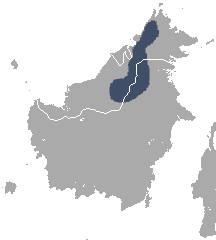Borneo mountain shrew
| Borneo mountain shrew | ||||||||||||
|---|---|---|---|---|---|---|---|---|---|---|---|---|
| Systematics | ||||||||||||
|
||||||||||||
| Scientific name | ||||||||||||
| Dendrogale melanura | ||||||||||||
| ( Thomas , 1892) |
The Borneo mountain pointed squirrel ( Dendrogale melanura ) occurs in two subspecies in the mountains of northern Borneo. Dendrogale melanura melanura , the nominate form , lives in northeastern Sarawak in the Crocker Range , on the Kinabalu and on the Trus Madi . Dendrogale melanura baluensis occurs on Dulit and Mulu in the Malaysian state of Sabah .
features
With a head-to-trunk length of 12 to 12.5 cm and a tail length of 13.5 to 14 cm, the Borneo mountain shrew is one of the smallest species of shrew . The ears are 12 to 14 mm high and the length of the rear foot is 28 to 31 mm. No data are available on the weight of the animals. Borneo mountain tupajas are brownish in color. In contrast to the shrews of the genus Tupaia found on Borneo , they have no light shoulder stripes. The hair is thin and long. The claws on the front and rear feet are long in adaptation to the arboreal (tree-dwelling) way of life.
Way of life
The Borneo mountain pointed squirrel is endemic to some mountains in the north of Borneo and occurs there in forests at altitudes of 900 to 3500 meters. Little is known about the way of life and behavior of the animals. The species may feed exclusively on insects and not eat fruit like other shrews. Various beetles were found in stomach examinations. As we know from observations and skeletal morphology, the animals are largely tree-dwelling and rarely go to the forest floor. So far nothing is known about the reproduction of the Borneo mountain shrew.
Danger
The IUCN does not specify a degree of risk for the Borneo mountain shrew since too little data is available. The species has not been seen since the early 1970s. In the lower altitudes of its range, the habitat is becoming increasingly smaller due to human impact.
Individual evidence
- ↑ a b c Melissa Hawkins: Family Tupaiidae (Treeshrews). In: Don E. Wilson and Russell A. Mittermeier (eds.): Handbook of the Mammals of the World. Volume 8: Insectivores, Sloths and Colugos. Lynx Edicions, Barcelona 2018, ISBN 978-84-16728-08-4 , pp. 242–269 (p. 263)
- ↑ Dendrogale melanura in the endangered Red List species the IUCN 2008. Posted by: Han, KH Stuebing, R., 2008. Accessed March 7 of 2019.
